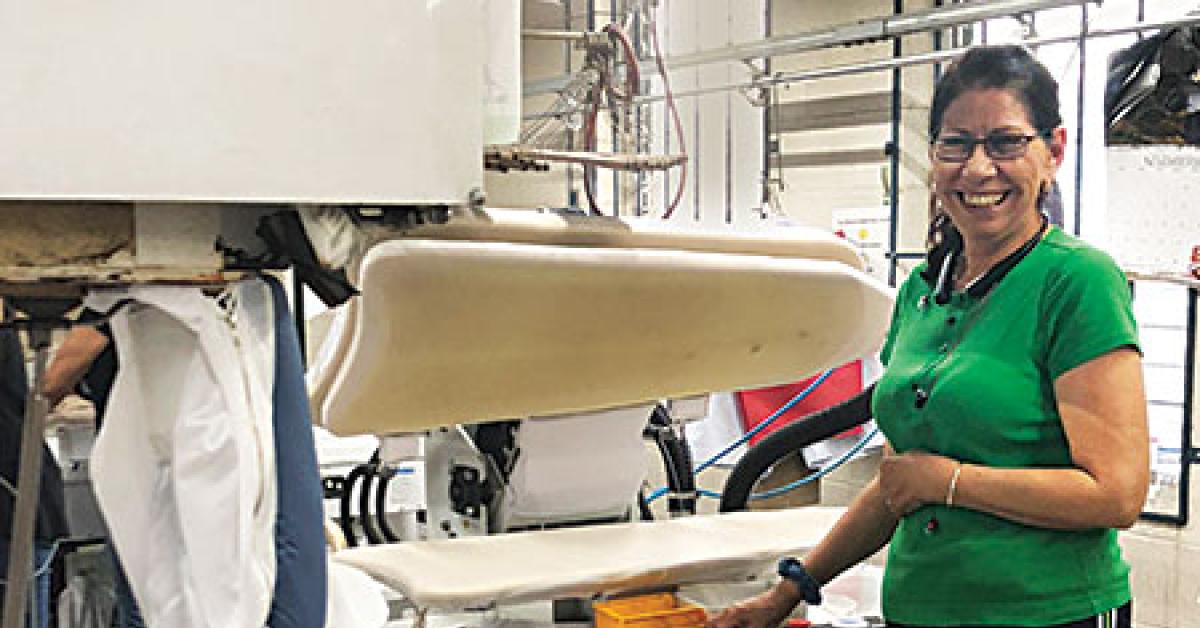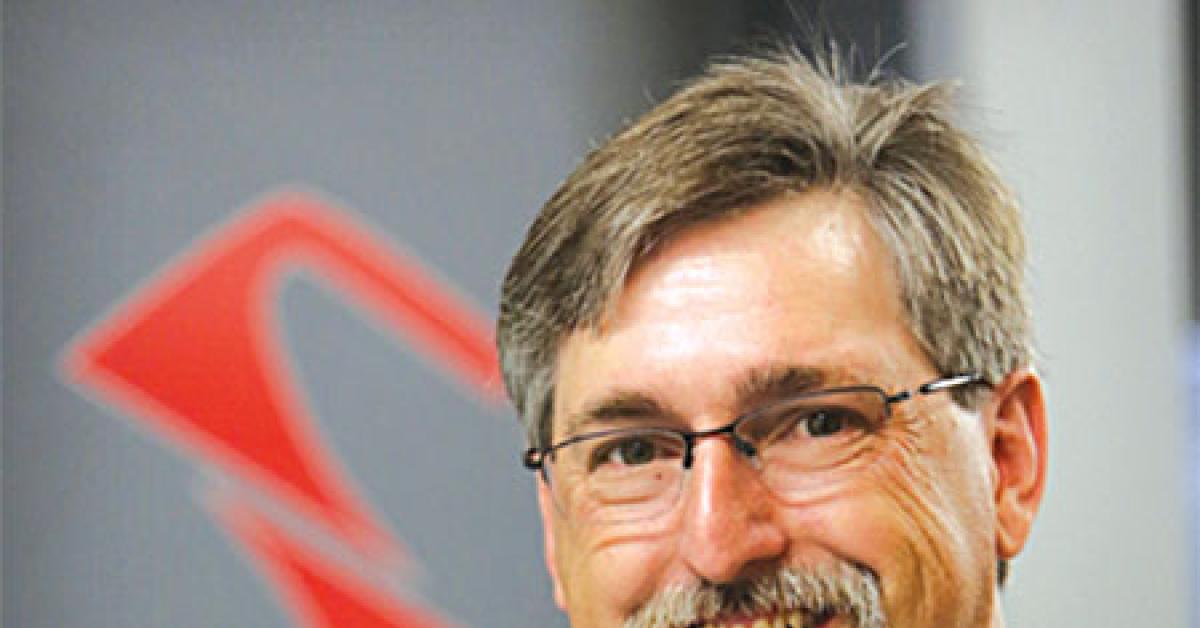CHICAGO — The new finishing equipment entering the market today is certainly making it easier for operators to finish garments, according to Jess Culpepper, president and general manager of Culpepper Cleaners in San Antonio, Texas.
“These improvements could not have come at a better time as it has become increasingly more difficult to find a finisher with experience,” he says.
His family has been in the drycleaning business since 1911.
“I entered in 1978 as the third generation to do so. At this time, we operate one plant and two drop stores. Our goal is and has been for 100-plus years to provide the best customer service, drycleaning and laundry service to the people of San Antonio.”
Culpepper relates that the new finishing equipment he installed is “very easy for the operator to learn to use properly with minimal training.”
Upping productivity is always on the minds of drycleaning operators on the finishing side. But the need to find experienced operators has also become pressing. It’s put the focus on technologically advanced machines that are easier for team members to operate.
EASY RIDER
“Is it easy to learn?” That could very well be the most-asked question in the finishing area for drycleaning owners.
Enter Stuart Ilkowitz, president, Mamaroneck, N.Y.-based Trevil America, in business since 1999 as the exclusive importer and distributor of Trevil equipment in the United States and Canada.
“Whereas a few years ago, the main question people asked about equipment pertained to productivity, as in, ‘How many can it produce in an hour?’” he says. “Now, the focus has changed to where they want the machines to be easy for anyone to operate while also productive and offering high quality.”
Michael “Stucky” Szczotka, co-owner, Troy, Mich.-based Poseidon Textile Care Systems, seems to agree when he notes that there have been many improvements and innovations in finishing equipment in recent years.
One of the most notable, he says, “is with flatwork ironers. More and more dry cleaners are installing them for quality ironing of sheets, pillowcases, table cloths, napkins and more. This allows dry cleaners to serve new revenue sources, such as hotels, restaurants and spas, for example.
“With improvement in ironers, operators can now go right from the wet wheel to the ironer without having to condition the goods in a dryer. This saves a lot of time!”
About her own drycleaning customers, Yuriko Tanabe, vice president, European Finishing Equipment Corp./Hi-Steam, based in Seacaucus, N.J., notes that her company's most popular machine remains its SAM-451, a multi-garment finisher for shirts, blouses, suit jackets and polo shirts, whether laundered or dry-cleaned.
Started in New York City in 1977, with gravity feed bottle iron and all steam iron, her firm around 1995 began offering Italian tensioning machines and vacuum boards, and later mini boilers.
What’s new today?
“Electric shirt finishing equipment, like the Turbo-Jr. (E), shirt finisher and CB-520 (E) collar and cuff press. We introduced them for those cleaners who do not have, do not want, or are not allowed to have an industrial boiler,” Tanabe explains.
“Our first customer was the laundry room at Lowes Regency Hotel in New York City, who removed their troublesome boiler with frequent repairs and inspections.” She indicates that they are happy to find a new alternative to the traditional finishing processes.
“Dry cleaners ask for machines with a smaller footprint, cooler to operate, easier to train, and reasonably priced,” she adds.
Tom Stites, sales manager at Unipress, says whenever he is speaking with a customer, labor costs are always one of the major topics of the conversation: “They ask, ‘How can I increase my production?’ Or, ‘will this save me labor?’”
Stites says his company’s name has been around for what seems like an eternity. “The company was actually reborn in 1982, with a new ownership group, new business model and a new manufacturing facility in Tampa, Fla. We manufacture a full line of shirt units, drycleaning finishing, wetcleaning finishing and laundry presses.”
Owners that successfully maximize their production are able to control their labor costs, Stites says.
“We strongly advocate that each pressing station should have production standards. The operators should be held accountable to adhere to the standards.”
An example of this, he relates, is that recently, a Unipress customer in New Jersey replaced two traditional-style shirt units that were operated by four employees, with two Hurricane double-buck shirt units, run by three operators.
His customer is now “exceeding over 185 shirts, and with the previous equipment, he was averaging 180 shirts an hour with four employees.”
The Hurricane features a touch-screen PLC that tracks real time production, Stites notes. The current hourly production, as well as the target rate, is displayed on the screen.
“Additionally, there is another highly visible display that monitors production with color-coded green, which means meeting the set standard; yellow, which indicates within 70% of the standard; and red, which is ‘unacceptable.’ This is used to motivate and remind the operator to keep on task.”
So what is Wesley Nelson, vice president of sales and COO at Sankosha USA Inc., Elk Grove Village, Ill., seeing in drycleaner demand today?
“Customers are inquiring more and more about tensioning equipment such as form finishers, pants toppers and drycleaning presses. They are finding out that tensioning equipment benefits plants that are processing garments by means of wet cleaning as well as dry cleaning,” Nelson relates.
As an example he says, “Recently a Tensioning Form Finisher was installed at a plant in Sonoma, Calif. The equipment it replaced was an old Suzie. Both the plant owner as well as the presser noticed on the first garment, which was a men’s sport coat processed on the new Tensioning Form Finisher, that the garment was basically ready for assembly.
“Other than some light touch up while the garment was already on the hanger, the sport coat never touched another press.”
Smart technology has come into everything in our lives and it’s in our drycleaning machines today.
As machines get smarter, where you think this “smart tech” on the finishing side is leading?
Nelson explains that the goal of smart tech, “as far as Sankosha is concerned, is to provide equipment that requires fewer touches on each garment by the operator.
“Due to the difficulty in finding experienced pressers, the newer equipment requires less and less pressing experience, and shortens expensive training time.
“The smart tech is in the controls where the operator can tailor the type of press or time needed for each type of garment. It must be simple and quick and easy to maintain production.”
“Simple,” “quick,” and “easy,” are words that come back more and more to describe today’s finishing needs. The machines are geared toward users understanding and operating on a general level. But are they understanding?
ARE WE THERE YET?
We see the flashing buttons. Hear the blast of air. But we want to know how it all really works, too.
So the question is: Do drycleaning owners and operators understand the technology in their finishing equipment?
Nelson says customers seem to have a very basic understanding of the new finishing technology: “Enough so that they can see the benefits of using tensioning equipment for garments that have not been wet-cleaned.
“We start-up and train a large portion of our equipment in the field. The owner and operators become familiar with the machines very quickly with the operation, the controls, and maintenance. Our controls are similar across our line of machines, which helps in a major way.”
To that same question, Stites replies, “Good question — and sometimes the best way to answer that is to compare it to a smartphone. Some people only use for a phone to communicate with friends and relatives. Then there are others that it becomes and integral part of their daily life. The more they use it, the more valuable it becomes.”
Ilkowitz thinks that most drycleaning owners and operators understand the technology in their equipment fairly well, but often they do not fully consider the day-to-day costs of owning and operating a machine.
“I recently spoke with someone who was certain that he did not want to buy a dedicated shirt-finishing machine because he didn’t want to invest that much money in equipment,” he points out as an example.
“After some conversation, I helped him to understand that it is not so much the cost of the equipment at the time of purchase that was the most important thing, but the cost of operating the machine every day that matters.
“When he realized how much money he was spending on labor to produce the quality and quantity of the shirts he needed to finish each week, it became clear that the shirt finishing machine wasn’t going to cost him a lot of money. It was actually going to make him a lot of money.”
In some ways, it seems to be a matter of viewpoint on the owners’ long-term return in finishing.
“So it’s not so much an issue of them understanding the technology of the equipment,” Ilkowitz relates, “as much as the bigger picture of labor savings, consistency of quality, and ease of training that requires more of a conversation.”
Back to our dry cleaner Jess Culpepper in San Antonio, Texas, who as the president of his company, naturally, will have the final word about finishing.
Culpepper notes that the new finishing equipment entering the market is certainly making it easier for operators to finish garments.
“These improvements could not have come at a better time as it has become increasingly more difficult to find a finisher with experience.
“I am definitely a fan of making things easier and better, so I am hopeful the equipment manufacturers continue to improve their products which in turn will help all of us in the drycleaning profession excel at providing our customers with impeccably finished garments.”
Can’t think of a better way to wrap up the article than to repeat his words: “Impeccably finished garments.” And now we are finished!
To read Part 1, go HERE.
Have a question or comment? E-mail our editor Dave Davis at [email protected].



